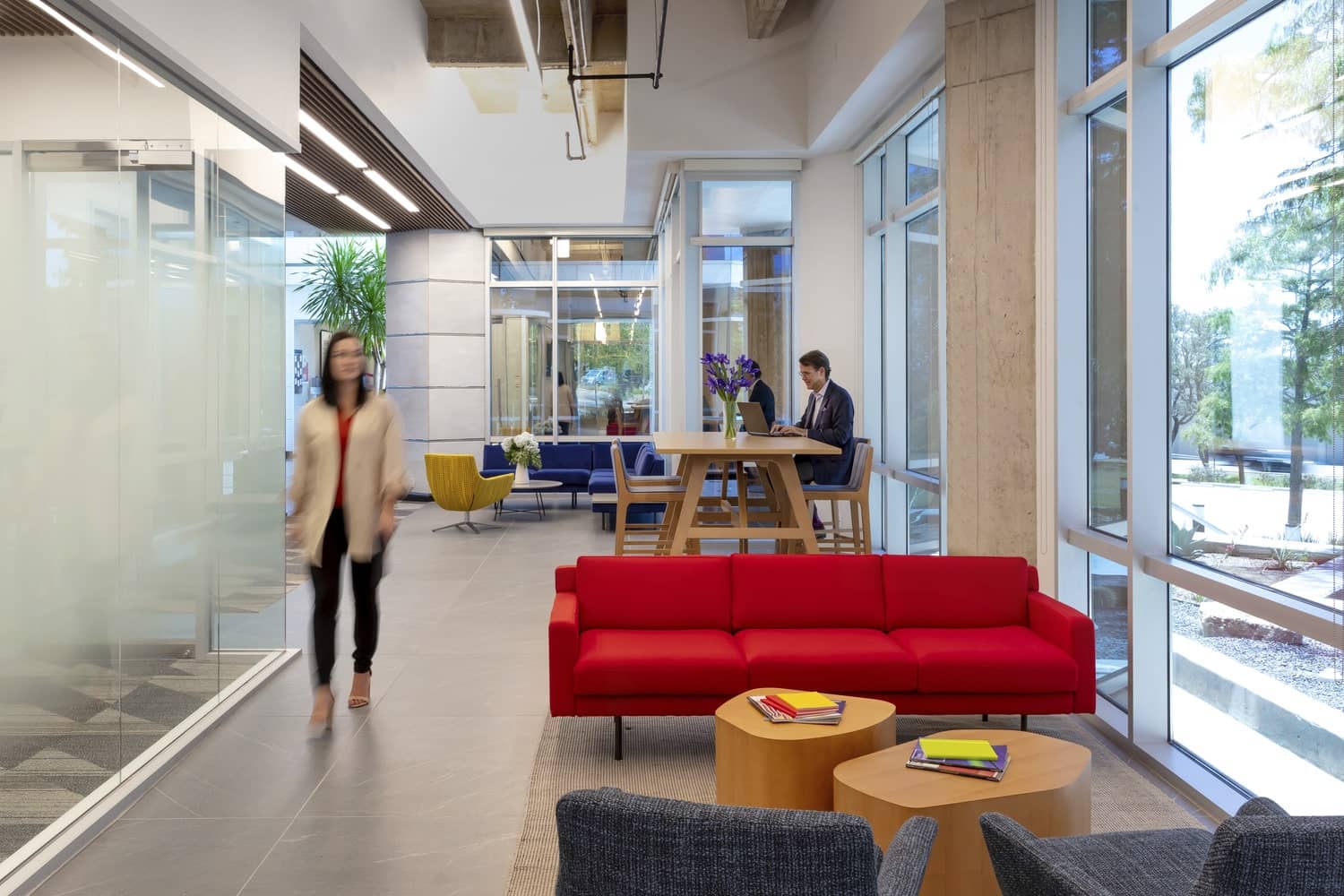Attorneys were uniquely impacted by the pandemic. Before March 2020, most law firms wouldn’t have dreamed of giving up their office space to work remotely. The legal industry is known for maintaining physical documents that need to be stored in large file cabinets in-office. Additionally, when preparing for trial, lawyers tend to spend long days, nights and weekends in the office preparing. New associates have benefitted from the in-person, in-office interaction being in the office facilitates.
At the beginning of the pandemic, many KBS legal tenants were the first to reach out about shrinking their office footprints. As time wore on, however, they became one of the first professions to return to the office on a daily basis.
It could be argued that legal wasn’t as fragmented as many other industries that allowed employees to go remote — even out of state — during the pandemic and its aftermath. Proximity to the courthouses is a significant part of day-to-day business for most law firms. Though court proceedings were done remote during the pandemic, most lawyers realize that eventually court filings, client meetings, appearing before judges, depositions, etc., all still need to be done in-person. And most firms can benefit by having attorneys central to where the company’s business is being conducted.
Some law firms, such as Fredrikson & Byron in Minneapolis, MN, took a proactive stance to update the traditional way of doing in-office business by averting being anchored down by paper. Fredrikson engaged employees in one of their biggest initiatives, the “Paperlite” campaign to digitize decades of documents and other paperwork — a task which was accelerated during the pandemic.
Not only was the initiative successful, it helped elevate the level of client service and efficiency. It also provided the Midwest law firm with a leg up as they prepared for a move into its new headquartered at KBS’ 60 South Sixth building in downtown Minneapolis.
“We began the planning for our new office space prior to the pandemic,” said Fredrikson’s James Snelson in KBS Premier magazine, “but we always recognized that we must effectively utilize the space to leverage hybrid work, boost collaboration and enhance our workforce’s well-being.
“There are many design elements [at 60 South Sixth] that facilitate hybrid work and improve well-being, including our investment in technology, the ability to work in the variety of interesting spaces outside a particular office, the installation of sit-to-stand desks and the great exercise facility in the building.”
Fredrikson CEO Ann Rainhart said that their new headquarters also provides a strategic advantage in a highly competitive field. “I believe we learn by observing others who are further along in their careers while doing substantive work together in a real environment,” she said. “They enjoyed the workspace and the opportunities of working in an in-person environment. According to the data coming out now, law students are interested in working in person at least some of the time, so I’m pleased that this has been part of our culture.”
The interesting approach in the legal profession is how leadership in large firms — which are otherwise competitors — have taken a united stance to drive this significant shift in office dynamics and in-person work. The shift to in-person was accelerate last year. In January 2023, Savill’s Law Firm Return-to-Office Survey, with about 70 firms participating, found that 34% of firms mandated three days per week in the office while another 33% “encouraged” it.
Fast forward to June 2023, in another iteration of that survey, which found the percentage of firms recommending or mandating in-office attendance had increased. The later survey found 90% of firms had implemented some kind of in-office policy, with 50% “recommending” a certain level of attendance and another 33% mandating it.
The seemingly best plan for return-to-office, firm leaders said, is just one of transparency, open communication and, to some degree, acceptance of what is and isn’t possible. And as law firms stabilize their working routines, it will become more palatable for all parties.
Savills also revealed that a larger percentage of U.S. law firms have expanded their office space in 2023 compared to 2022, reflecting a preference for a return to face-to-face collaboration within the industry.
According to the findings, 42.6% of law firm transactions in the first three quarters of 2023 involved expansions, signaling a notable increase from the 28.5% reported for the entire year of 2022. This surge in expansion highlights the legal industry’s commitment to reestablishing a physical presence in the workplace.
For instance, Davis, Polk & Wardwell’s expanded its midtown Manhattan offices by an additional 30,000 square feet, bringing it to a total of 710,000. It is a key example of this trend and is the largest legal industry lease since 2021.
“The legal services sector has been a bright spot, at least in Manhattan, for commercial real estate this year,” says Reuters. “Savills said the legal sector was the most active industry in Q2 and Q3 [of 2023], and anticipated it would have an ‘outsized impact’ on leasing through the end of the year.”
According to a September 2023 Law.com article, the resurgence is largely regional, with some international cities returning to five days a week.
“‘Like many aspects of law firm business practices, office attendance policies at law firms are driven by clientele and the attorney hiring market,” said Anthony Davies, chief revenue officer of Forrest Solutions, which works with law firms on workplace experience.
In the Law.com article, a comparison is made between Quinn Emanuel’s Southern California office and its London location, which is in a large financial center. California’s legal culture hasn’t been pushing for a return nearly as hard as New York and London but London has the leverage of having their banking and financial services clients in the office five days a week. If these are your major clients and they’re all in the office, you want to be where they are.
Law firms face the challenge of deciding between a single, uniform office policy across all locations or adopting nuanced approaches that account for regional variations. While a consistent policy simplifies communication, it may lack the capacity for nuance required to accommodate diverse cultural, client, and market dynamics.
Katten Muchin Rosenman’s “KattenFlex” approach is one type of strategy, where leaders in the practice’s larger U.S. offices determine who should be in office based on client needs, the firm’s culture, and structured in-person collaboration. “This flexible approach seeks to balance the need for flexibility with the value of in-person connections.”
Law.com reports that many firms have gotten very creative by incentivizing office attendance by tying bonuses to in-person presence. Firms such as Ropes & Gray, Simpson Thacher & Bartlett, Sidley Austin, Davis Polk & Wardwell, and Cahill Gordon & Reindel have implemented bonus structures linked to office attendance, signaling a strong push for a return to physical workspaces.
Citing the CBRE Law Firm Benchmarking Survey Results 2024, Globe Street recently reported that “among all professional groups, one of the most resistant to remote work is the legal profession.” In short, law firms aren’t fond of remote work arrangements.
The CBRE Survey states that “the legal industry has been at the forefront of setting office attendance policies requiring in-office work.” According to the survey, 83% of the biggest law firms and 73% of the smaller ones said they would prefer more in-office working — with employee retention and attracting talent being the most important drivers when it comes to choosing the right office.
Law firms will continue to find a balance between the benefits of in-person collaboration and the evolving expectations of a workforce that has become accustomed to greater flexibility. It’s clear that the legal profession is creating some innovative and unusual ways to bring professionals back to the workplace — which will, hopefully, drive greater utilization and expansion of commercial real estate.
Learn more by visiting KBS.com/Insights.




